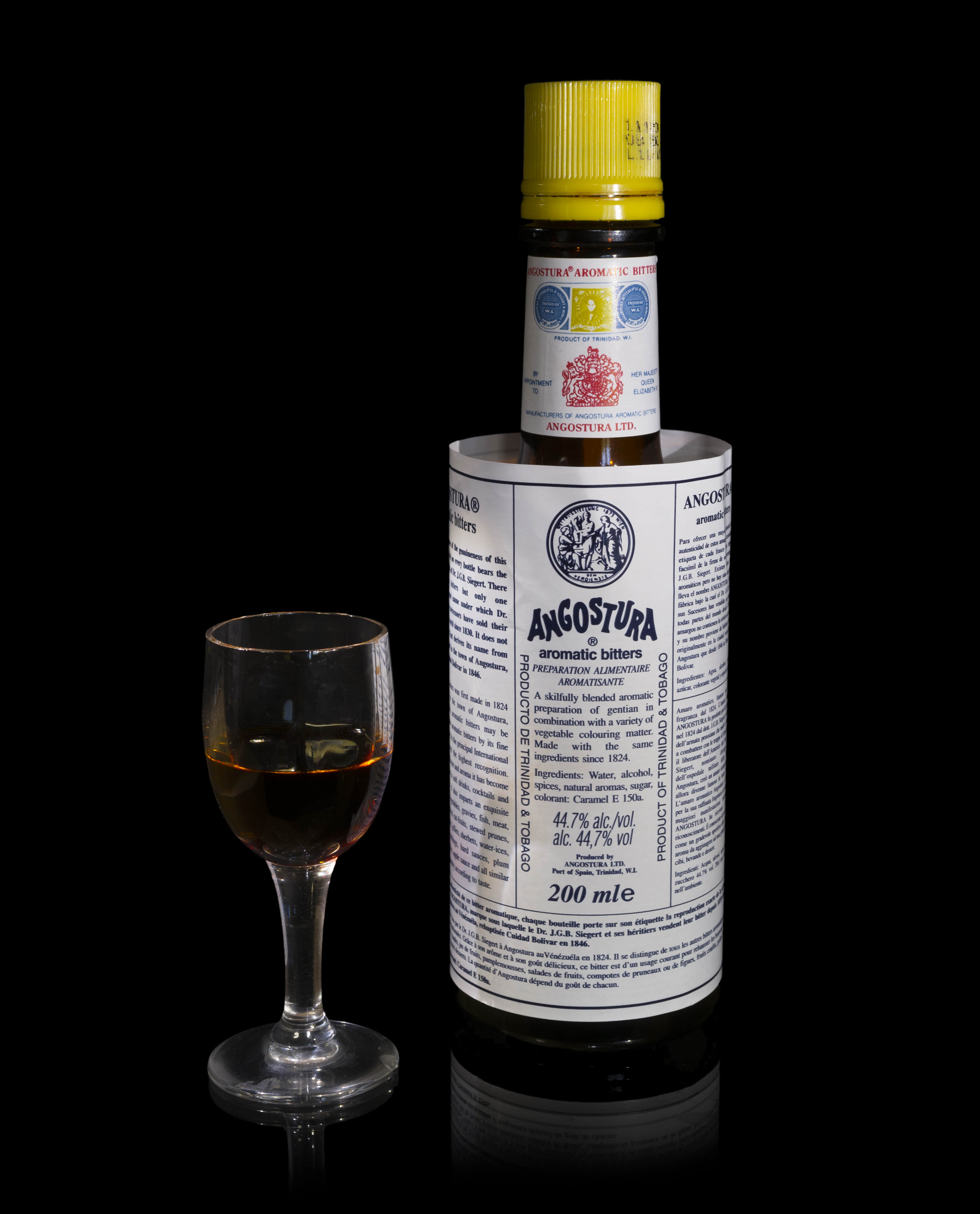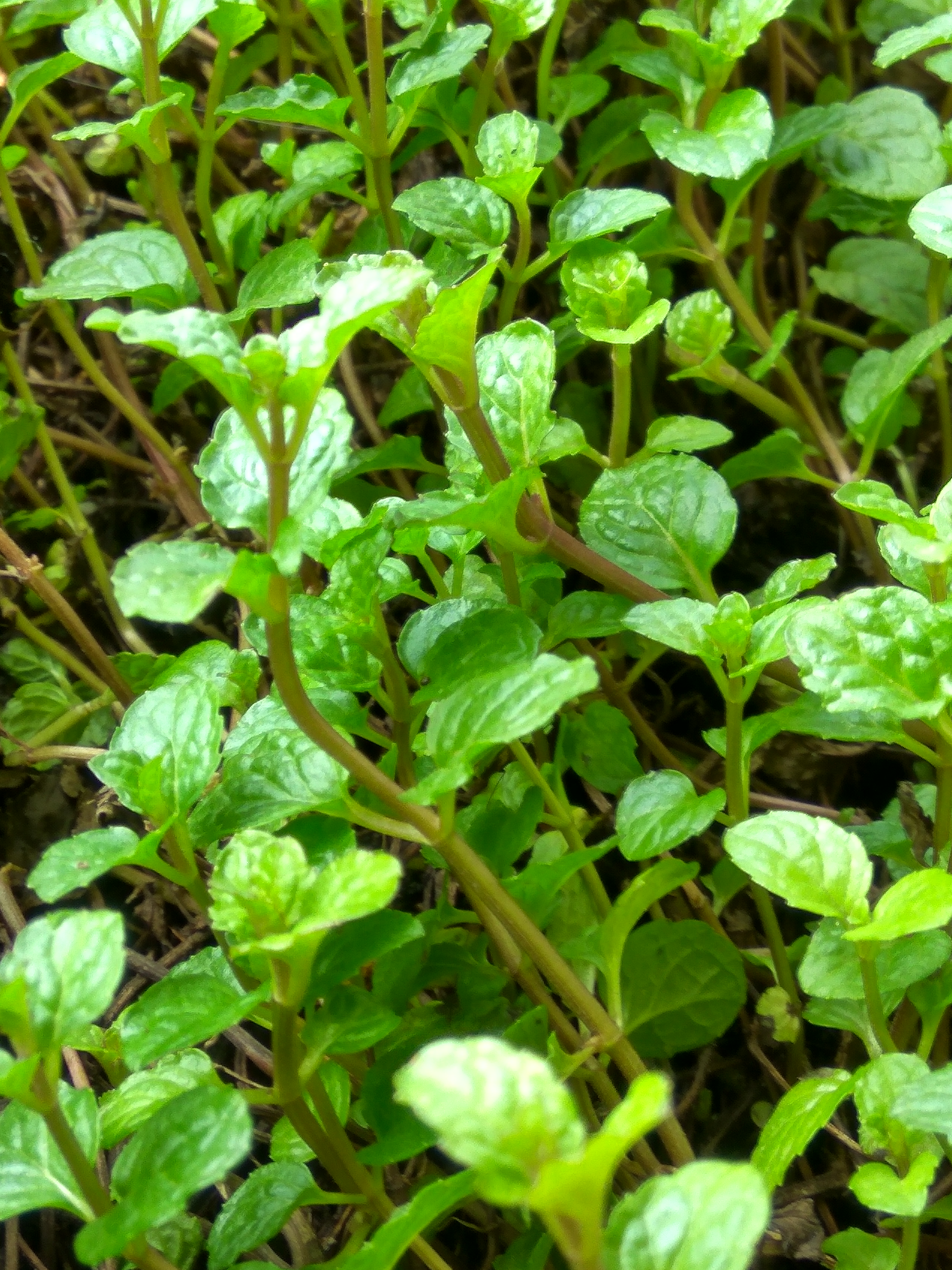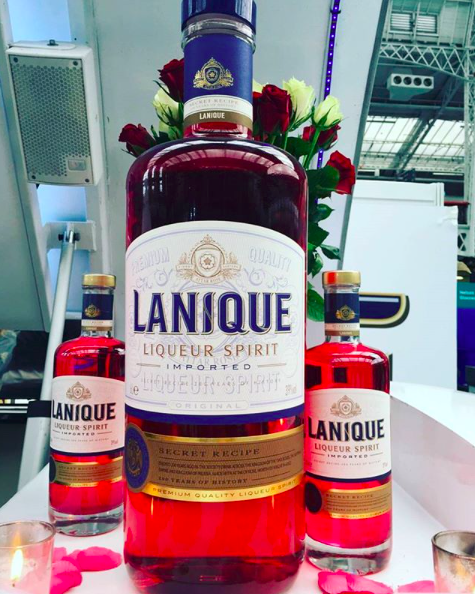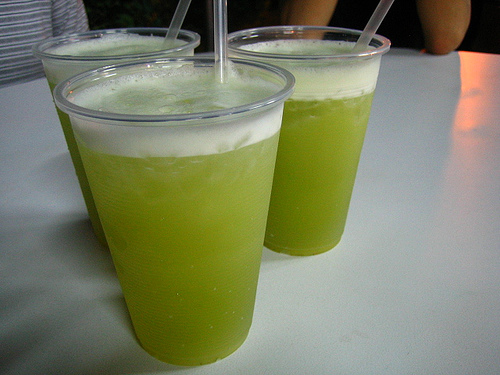|
Mojito
Mojito (; ) is a traditional Cuban punch. The cocktail often consists of five ingredients: white rum, sugar (traditionally sugar cane juice), lime juice, soda water, and mint. Its combination of sweetness, citrus, and herbaceous mint flavors is intended to complement the rum, and has made the mojito a popular summer drink. When preparing a mojito, fresh lime juice is added to sugar (or to simple syrup) and mint leaves. The mixture is then gently mashed with a muddler. The mint leaves should only be bruised to release the essential oils and should not be shredded. Then rum is added and the mixture is briefly stirred to dissolve the sugar and to lift the mint leaves up from the bottom for better presentation. Finally, the drink is topped with crushed ice and sparkling soda water. Mint leaves and lime wedges are used to garnish the glass. In Cuba, the mint used to make mojito is most commonly Mentha × villosa (called Yerba Buena or Hierbabuena in Cuba) which has a light min ... [...More Info...] [...Related Items...] OR: [Wikipedia] [Google] [Baidu] |
Mentha × Villosa
''Mentha'' x ''villosa'' (syn: ''Mentha alopecuroides'', ''Mentha nemorosa'', ''Mentha villosa'' var. ''alopecuroides'') is a hybrid species of mint, a cross between ''Mentha spicata'' and ''Mentha suaveolens''. The mint is traditionally used as a core ingredient in Cuba in the famous Mojito, where it is known as yerba buena or hierbabuena. (the drink is often made with spearmint outside of Cuba) Description ''Mentha'' x ''villosa'' is a herbaceous, rhizomatous, perennial plant that grows to be tall, with smooth stems, square in cross section. The rhizomes are wide-spreading and fleshy, and bear fibrous root In vascular plants, the roots are the organs of a plant that are modified to provide anchorage for the plant and take in water and nutrients into the plant body, which allows plants to grow taller and faster. They are most often below the su ...s. Cultivation ''Mentha'' x ''villosa'' grows best in moist soil and part-full sun. The variety was not commonly ava ... [...More Info...] [...Related Items...] OR: [Wikipedia] [Google] [Baidu] |
Mentha
''Mentha'' (also known as mint, from Greek , Linear B ''mi-ta'') is a genus of plants in the family Lamiaceae (mint family). The exact distinction between species is unclear; it is estimated that 13 to 24 species exist. Hybridization occurs naturally where some species' ranges overlap. Many hybrids and cultivars are known. The genus has a subcosmopolitan distribution across Europe, Africa - (Southern Africa), Asia, Australia - Oceania, North America and South America. Its species can be found in many environments, but most grow best in wet environments and moist soils. Description Mints are aromatic, almost exclusively perennial herbs. They have wide-spreading underground and overground stolons and erect, square, branched stems. Mints will grow 10–120 cm (4–48 inches) tall and can spread over an indeterminate area. Due to their tendency to spread unchecked, some mints are considered invasive. The leaves are arranged in opposite pairs, from oblong to lanceolate ... [...More Info...] [...Related Items...] OR: [Wikipedia] [Google] [Baidu] |
Cojito
The Cojito is a sweet cocktail made with lime and mint, and typically rum and coconut. It is a variant of the mojito, but typically adds coconut flavor. This can be done by adding coconut milk or coconut-flavored liqueurs, or by using coconut-flavored rum such as Blue Chair Bay, Cruzan coconut, or Malibu. Coconut on the rim of the cocktail glass may also be used. The use of coconut rum gives the Cojito a more "tropical" taste than the mojito. The strong minty taste may lead some to adjust downward the quantity of fresh mint leaves used. Variants Several variants of the Cojito exist: * The ''sparkling Cojito'' includes seltzer water. Similarly, lemon-lime soda can be included in the recipe. * ''Herbal Cojitos'' may include basil and even lemongrass as ingredients. * The ''Co Cojito'', originated by the self-described "Restaurant & Chocolate Boutique" Co Co. Sala in Washington, DC, is based on chocolate-infused vodka and adds dark chocolate flakes as a flavoring agent, in add ... [...More Info...] [...Related Items...] OR: [Wikipedia] [Google] [Baidu] |
White Rum
Rum is a liquor made by fermenting and then distilling sugarcane molasses or sugarcane juice. The distillate, a clear liquid, is usually aged in oak barrels. Rum is produced in nearly every sugar-producing region of the world, such as the Philippines, where Tanduay is the largest producer of rum globally. Rums are produced in various grades. Light rums are commonly used in cocktails, whereas "golden" and "dark" rums were typically consumed straight or neat, iced (" on the rocks"), or used for cooking, but are now commonly consumed with mixers. Premium rums are made to be consumed either straight or iced. Rum plays a part in the culture of most islands of the West Indies as well as the Maritime provinces and Newfoundland, in Canada. The beverage has associations with the Royal Navy (where it was mixed with water or beer to make grog) and piracy (where it was consumed as bumbo). Rum has also served as a medium of economic exchange, used to help fund enterprises such as ... [...More Info...] [...Related Items...] OR: [Wikipedia] [Google] [Baidu] |
Angostura Bitters
Angostura bitters () is a concentrated bitters (herbal alcoholic preparation) based on gentian, herbs, and spices, by House of Angostura in Trinidad and Tobago. It is typically used for flavouring beverages or, less often, food. The bitters were first produced in the town of Angostura (now Ciudad Bolívar, Venezuela), hence the name, but do not contain angostura bark. The bottle is recognisable by its distinctive oversized label. ''Angostura'' is Spanish for 'narrowing', the town of Angostura having been at the first narrowing of the Orinoco River. Beverages named "Angostura Bitter" or "Angobitter" are also offered from other brands (e.g., Riemerschmid, Hemmeter). Unlike the House of Angostura product, they contain angostura bark, possibly to justify the use of the word "Angostura" in their names. History The recipe was developed as a tonic by , a German surgeon general in Simón Bolívar's army in Venezuela. Siegert began to sell it in 1824 and established a distillery for ... [...More Info...] [...Related Items...] OR: [Wikipedia] [Google] [Baidu] |
Spearmint
Spearmint, also known as garden mint, common mint, lamb mint and mackerel mint, is a species of mint, ''Mentha spicata'' (, native to Europe and southern temperate Asia, extending from Ireland in the west to southern China in the east. It is naturalized in many other temperate parts of the world, including northern and southern Africa, North America, and South America. It is used as a flavouring in food and herbal teas. The aromatic oil, called ''oil of spearmint'', is also used as a flavoring and sometimes as a scent. The species and its subspecies have many synonyms, including ''Mentha crispa'', ''Mentha crispata,'' and ''Mentha viridis''. Description Spearmint is a perennial herbaceous plant. It is tall, with variably hairless to hairy stems and foliage, and a wide-spreading fleshy underground rhizome from which it grows. The leaves are long and broad, with a serrated margin. The stem is square-shaped, a defining characteristic of the mint family of herbs. Spearmint prod ... [...More Info...] [...Related Items...] OR: [Wikipedia] [Google] [Baidu] |
El Floridita
Floridita () or El Floridita is a historic fish restaurant and cocktail bar in the older part of Havana (''La Habana Vieja''), Cuba. It lies at the end of '' Calle Obispo'' (Bishop Street), across Monserrate Street from the National Museum of Fine Arts of Havana (Museo Nacional de Bellas Artes de La Habana). The establishment is famous for its daiquiris and for having been one of the favourite hangouts of Ernest Hemingway in Havana. The bar now boasts a life size bronze statue of Ernest Hemingway positioned in his favourite spot at the end of the bar. On a small plaque hanging in El Floridita, hangs Hemingway's signed quote: "My mojito in the Bodeguita del Medio and my daiquiri in the Floridita". History The bar opened in 1817 with the name "La Piña de Plata" (English: ''The Silver Pineapple'') in the place it still occupies, on the corner of Obispo and Monserrate streets. Almost 100 years later, the large number of North American tourists persuaded the owner to change the name ... [...More Info...] [...Related Items...] OR: [Wikipedia] [Google] [Baidu] |
Mojo (sauce)
Mojo (, from Portuguese ''molho'' , meaning "sauce") is the name, or abbreviated name, of several types of sauces, varying in spiciness, consisting primarily of olive oil, local pepper varieties (called ''pimienta'' in the Canary Islands), garlic, paprika (called ''pimentón'' in Spain), cumin or coriander, and other spices. Mojo originated in the Canary Islands, where the main varieties are green mojo (''mojo verde''), red mojo (''mojo rojo''), and spicy red mojo (''mojo picón''). Other countries have recipes similar to mojo, where acidic ingredients such as vinegar, lemon, orange, or lime juice may be used. Canarian mojo Typology Green mojo, or mojo containing green spices, is commonly used for fish, especially the proper ''green mojo'' (made with green pepper) but also coriander mojo (''mojo de cilantro'') and parsley mojo (''mojo de perejil''). As coriander mojo and parsley mojo contain some water, they need to be kept in the refrigerator and have to be consumed within ... [...More Info...] [...Related Items...] OR: [Wikipedia] [Google] [Baidu] |
Lanique
Lanique is a strong 39% spirit liqueur made with Attar of Rose that is created by steam distilling thousands of rose petals. Lanique is often used in classic cocktails to add a unique rose twist to them or due to its high alcohol strength as a drink in its own right with tonic or lemonade. It is now produced in the UK and owned by a Jersey based company. History Lanique traces its roots back to the late 1700s in the Kingdom of Prussia and variations were drunk across parts of Europe including in The Kingdom of the Two Sicilies and the Austrian Empire. The original creator is believed to have been a Princess whose castle overlooked and owned the original distillery in what is now modern day Poland. Lanique was popular through the 1800s and right up to the 1920s at high society balls and was often drunk neat in small tasting glasses. The drink was lost during the Second World War and rise of Communism across Eastern Europe. In 1990 after the opening up of Poland and the re ... [...More Info...] [...Related Items...] OR: [Wikipedia] [Google] [Baidu] |
Light Rum
Rum is a liquor made by fermenting and then distilling sugarcane molasses or sugarcane juice. The distillate, a clear liquid, is usually aged in oak barrels. Rum is produced in nearly every sugar-producing region of the world, such as the Philippines, where Tanduay is the largest producer of rum globally. Rums are produced in various grades. Light rums are commonly used in cocktails, whereas "golden" and "dark" rums were typically consumed straight or neat, iced ("on the rocks"), or used for cooking, but are now commonly consumed with mixers. Premium rums are made to be consumed either straight or iced. Rum plays a part in the culture of most islands of the West Indies as well as the Maritime provinces and Newfoundland, in Canada. The beverage has associations with the Royal Navy (where it was mixed with water or beer to make grog) and piracy (where it was consumed as bumbo). Rum has also served as a medium of economic exchange, used to help fund enterprises such as sla ... [...More Info...] [...Related Items...] OR: [Wikipedia] [Google] [Baidu] |
Sugar Cane Juice
Sugarcane juice is the liquid extracted from pressed sugarcane. It is consumed as a beverage in many places, especially where sugarcane is commercially grown, such as Southeast Asia, the Indian subcontinent, North Africa, and Latin America. Sugarcane juice is obtained by crushing peeled sugar cane in a mill and is one of the main precursors of rum. In the United States where processed sugarcane syrup is used as a sweetener in food and beverage manufacturing, "evaporated cane juice" is considered by the Food and Drug Administration (FDA) to be a misleading term for "sugar" on product labels because the FDA regards "juice" as a liquid derived from fruits or vegetables; the preferred term is "cane sugar". Health risks Raw sugar cane juice can be a health risk to drinkers due to the unhygienic conditions under which it is prepared in some countries with lower health standards. There are some diseases that can be transmitted by raw sugar-cane, such as Leptospirosis. In Brazil, su ... [...More Info...] [...Related Items...] OR: [Wikipedia] [Google] [Baidu] |
Coconut
The coconut tree (''Cocos nucifera'') is a member of the palm tree family (Arecaceae) and the only living species of the genus ''Cocos''. The term "coconut" (or the archaic "cocoanut") can refer to the whole coconut palm, the seed, or the fruit, which botanically is a drupe, not a nut. The name comes from the old Portuguese word '' coco'', meaning "head" or "skull", after the three indentations on the coconut shell that resemble facial features. They are ubiquitous in coastal tropical regions and are a cultural icon of the tropics. The coconut tree provides food, fuel, cosmetics, folk medicine and building materials, among many other uses. The inner flesh of the mature seed, as well as the coconut milk extracted from it, form a regular part of the diets of many people in the tropics and subtropics. Coconuts are distinct from other fruits because their endosperm contains a large quantity of clear liquid, called ''coconut water'' or ''coconut juice''. Mature, ripe coconuts ... [...More Info...] [...Related Items...] OR: [Wikipedia] [Google] [Baidu] |









